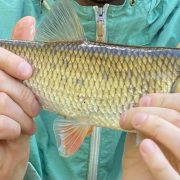November fauna – where have all the bunnies gone?
There is admittedly no obvious connection between jellyfish, numbats and ceramics, but walking up Bradlow Hill on a mild and misty morning, with no sightings of any fauna, not even sheep, any imagination can get carried away and a yearning for the exotic can take over when the landscape starts turning into a monochrome dun colour. The only thing that caught my eye was a large parasol mushroom.
Talking to the local butcher about rabbit (there was one for sale on display) it was a surprise to find out that there are no longer the numbers that existed only ten years ago. Travelling by train used to guarantee fields and meadows with bunnies running along the hedgerows. The main reason for this change is Rabbit Haemorrhagic Disease 2, or RHD 2, a disease with a mortality rate of over 90% which has all but wiped out wild rabbit populations across Europe.
Scientists, researchers and conservationists from across the UK have announced in the latest State of Nature report that the nation’s wildlife is continuing to decline despite efforts to reverse these trends. In fact, since the 1970s, it has been shown that 41% of all UK species studied have declined. This, plus the impending recession that will soon be upon us, and the Russian invasion of Ukraine, and the sports-washing about to take place in Qatar, is all very depressing – so anything is welcome that takes one’s mind off the issues.
Nevertheless, a cute little numbat was not expected to suddenly pop out from behind a hedge in Frith Wood, but nevertheless, a rabbit or two surely could have made an appearance. Why all this stuff about numbats, you ask?
Well, celebrations and events in November are numerous, but one in particular I know you will be upset you’ve missed is not the Day of the Dead, or Guy Fawkes Night (5th Nov), or even the FIFA World Cup, but November 6th, which is World Numbat Day. It is an insectivorous marsupial which only eats termites. This furry little Australian is an endangered species. The first ever drawing of a Numbat is by George Fletcher Moore who drew it in his diary on 22 September 1831, after seeing one of the animals for the first time during an expedition.
And World Jellyfish Day (3rd November)! Yes, a day to appreciate and celebrate jellyfish, which are not, in fact, fish or made of jelly. They have no heart or brain (yes, yes, I am sure we can all think of someone who fits the description), but nevertheless, do quite well stunning their prey with their stinging tentacles and gobbling them up. Some are quite beautiful, so here’s a link to a video of jellyfish that will help you relax.
Where would anyone go to see such exotic animals? Luckily, if you live in London, you can visit Regent’s Zoo and spend time admiring your fellow creatures there. Warthogs, pigmy hippos, okapis, lemurs, hummingbirds, butterflies, and once you’re satiated with wonder, what to do?
Why, only a stone’s throw from the zoo is the Cecilia Colman Gallery where you can continue your immersion in the sublime and extraordinary by gazing at the handmade pieces on offer, including vases by Peter Arscott Ceramics.
The gallery, which was opened in 1977 in what was then a sleepy High Street in St. Johns Wood, is today part of a bustling cosmopolitan centre, and one of the few places still remaining from the 1970s.
One of the pieces is a Matisse vase. Totally inspired by Matisse’s painting, Red Interior, with bold red and green colours applied with confident brushstrokes depicting an interior with glimpses of a garden outside. A stoneware vase, like all of them, slab-rolled and glaze-fired at a temperature of 1275°. Click here if you want a glimpse of the painting – copyright rightly prevents its inclusion in this blog.
Spiro (Head of Marketing) says: “You may think that doing any Christmas shopping in November is too early, but it does help retailers and it means less stress as the pre-Christmas frenzy builds up into its seasonal crescendo in December. Furthermore, a visit to the gallery allows you the opportunity to buy that handmade one-off gift for that special person – namely you”.
Since this is an animal-heavy blog, it’s worth knowing that Matisse was an animal lover, and that he was devoted to his three feline companions named Cousi, Minouche, and La Puce. He is even said to have fed his cats brioche bread every morning. Matisse, also a lover of birds, had pet doves, which he purchased from vendors along the Seine.
Au revoir.




























































































































